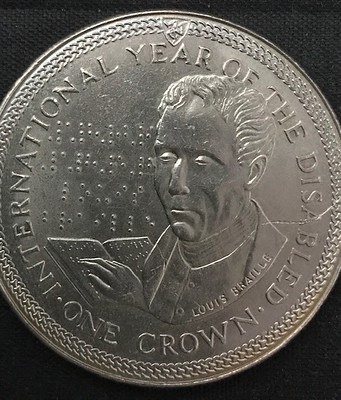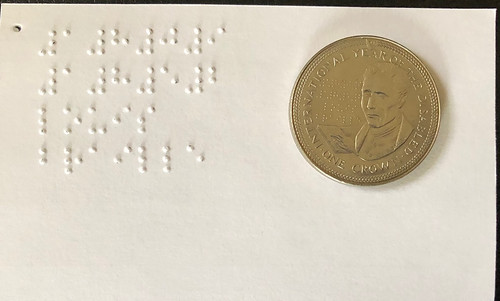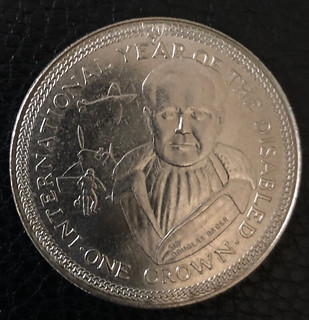
PREV ARTICLE
NEXT ARTICLE
FULL ISSUE
PREV FULL ISSUE
INTERNATIONAL YEAR OF DISABLED PERSONS COINSIn his Blind Coin Collector blog February 1, 2020, Tom Babinszki wrote about the International Year of Disabled Persons series, featuring coins from the Isle of Man. With permission, we're republishing it here. Thanks, Tom. I wasn't aware of this series. -Editor In 1981, the Isle of Man released four 1 Crown coins celebrating the international Year of Disabled Persons (IYDP). With this, they issued almost ten percent of the entire series. Though the coins are identical in measurement, they represent a diverse history and are unique in many ways. Before we look at the coins, it is important to put the Isle of Man into a greater perspective to understand the diversity of coins. The head of state is the Queen of the United Kingdom, holding the title of Lord of Mann, but the isle has retained self-governance. It is not part of the European Union, but according to the Treaty of Rome, it is part of the EU's customs area. This means that the Isle of Man is part of the Brexit negotiation. The Isle of Man is located in the Irish Sea, has the size of 221 square miles, and according to the 2016 census has a population of 83314 people. One of the island's main revenue is tourism. The currency on the Isle of Man is the Manx Pound, but the Pound Sterling is also accepted as a secondary currency. The value of one Manx Pound is exactly one Pound Sterling. The Manx Pound is not recognized as legal tender in the United Kingdom. Just like on many small islands, one source of income is the sale of commemorative coins, which explains the higher ratio of IYDP coins. Until 2016 the coins were minted at the Pobjoy Mint, but since 2017 at the Tower Mint. The coinage of the Isle of Man are quite collectable, they often change the design on the circulating coins and issue many commemoratives. According to Numista, at the time of this writing, there are 1136 coins listed under the Isle of Man. After this unfairly brief introduction, let's look at the IYDP coins. While the circulating coins are the Pound which is 100 Pence, all four IYPD coins are of the value of 1 Crown, and they are all considered to be commemorative issues. All four coins are dated 1981 and have the exact same features: 28.47 g weight, 38.61 mm diameter, made of copper-nickel, and the thickness is not As there is very little information out there about this series, I have contacted the Pobjoy Mint for more information. The only thing they were able to produce from 1981 is a brochure of the coins, though I did find out that it is not an accident that the coin designers are not listed. Interestingly, many of the Pobjoy Mint's coins are not designed by one person only, rather it is more of a staff effort. The text on all four coins say “International Year of the Disabled”, which is probably due to design consideration, but because of this the “International Year of Disabled Persons” is often, incorrectly being referred to, particularly in numismatic literature as the “International Year of the Disabled”. The four coins commemorate the following people:
The four people represent different types of disabilities, and also different contributions to the life of people with disabilities. Let's look at the coins one by one. Louis Braille 1 Crown
 Most likely Louis Braille needs very little introduction, he has been one of the most influential figures impacting the life of people with disabilities. Braille lived between 1809 and 1852. He invented a writing system for blind people, named braille after him, and is still used today. The word braille, referring to the writing system is often spelled with a capital “B”, my understanding is that when it refers to the writing system it is spelled with a lower-case “b”. There is an extensive literature about Louis Braille, and there is nothing I can add in the context of this writing, so I would encourage you to find information about him on the internet or in your library. What is not so widely known though, is that this was the first commemorative coin in history which contained braille writing. The first circulation coin containing braille was the Italian 500 Lire from 1982. It is worth noting that the braille script on the 1 crown coin is not for blind people to feel, rather for awareness purposes. Braille script is also not used in a conventional way. A braille number consists of letters from “a” to “j”, with a number sign in front to indicate that it is a number. The number sign should appear only once, but on the coin each number is preceded by a number sign. On the other hand, capital sign is not used in front of the name of Louis Braille. Braille letters are much larger than printed letters simply because a similarly small font cannot be accurately felt by touch. Therefore, a small printed book would be several volumes in braille. For the sake of comparison, on the following picture you can see the coin itself, with the same braille script side by site with regular size braille characters, which can be read by blind people.  Ludwig van Beethoven 1 Crown
Sir Douglas Bader  Sir Douglas Bader is the only one of the four people featured in this series who was on a coin during his lifetime, though he died in 1982 a year after the coin was issued. When we look at the Sir Douglas Bader 1 Crown, it is certainly not disability what comes to mind first. The coin has two airplanes, a man is just getting into one, who is Sir Douglas Bader. Bader joined the Royal Air Force, but at the age of 21, in 1931, both of his legs had to be amputated due to an accident. Though he was almost ready to give up his dream of flying when the Second World War broke out, and due to the shortage of pilots he was allowed to join the Air Force again. From this time of his life, he was probably best known about the Duxford Wing, a formation of five squadrons. After the war he worked as an executive at Royal Dutch Shell and also spent time visiting and supporting injured servicemen. He was knighted in 1976 for his service to amputees, and died in 1982. He is an example of how to continue living a fulfilling life with a disability, which at his age was much more difficult than it is today. Continuing his legacy, his grandson Charley Bickers created Britain's first air-display team with only disabled people. The BBC created a short video about it, it is absolutely worth watching. To watch the BBC video, see: Meet the UK's first disabled air display team - BBC Stories (https://www.youtube.com/watch?v=drN4HaBM5hA) Sir Francis Chichester 1 Crown
To read the complete article, see:
 Wayne Homren, Editor The Numismatic Bibliomania Society is a non-profit organization promoting numismatic literature. See our web site at coinbooks.org. To submit items for publication in The E-Sylum, write to the Editor at this address: whomren@gmail.com To subscribe go to: https://my.binhost.com/lists/listinfo/esylum All Rights Reserved. NBS Home Page Contact the NBS webmaster 
|